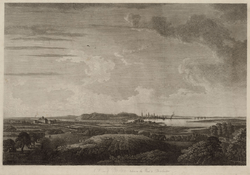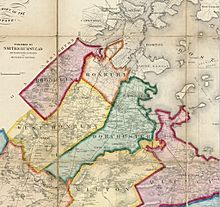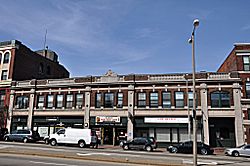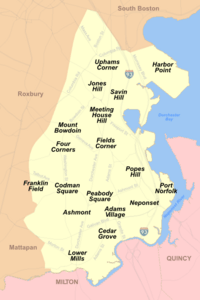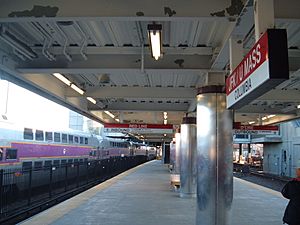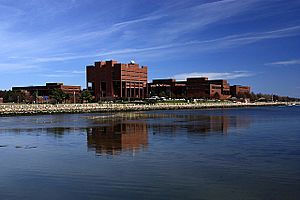Dorchester, Boston facts for kids
Quick facts for kids
Dorchester, Boston
|
||
|---|---|---|

Neponset River at Lower Mills (2009). Dorchester on the left, Milton on the right (south) side of the river.
|
||
|
||
| Nickname(s):
Dot
|
||
| Motto(s):
Pietate, Literis, Industria (Latin)
"Piety, Learning, [and] Industry" |
||
| Country | United States | |
| State | Massachusetts | |
| County | Suffolk | |
| Neighborhood of | Boston | |
| Settled | May 1630 | |
| Incorporated | June 1, 1630 | |
| Annexed by Boston | January 4, 1870 | |
| Population
(2010)
|
||
| • Total | 91,982 to 134,000 | |
| Time zone | UTC-5 (Eastern) | |
| • Summer (DST) | UTC-4 (Eastern) | |
| ZIP Codes |
02121, 02122, 02124, 02125
|
|
| Area code(s) | 617 and 857 | |
Dorchester (colloquially referred to as Dot) is a Boston neighborhood comprising more than 6 square miles (16 km2) in the City of Boston, Massachusetts, United States. Originally, Dorchester was a separate town, founded by Puritans who emigrated in 1630 from Dorchester, Dorset, England, to the Massachusetts Bay Colony. This dissolved municipality, Boston's largest neighborhood by far, is often divided by city planners in order to create two planning areas roughly equivalent in size and population to other Boston neighborhoods.
The neighborhood is named after the town of Dorchester in the English county of Dorset, from which Puritans emigrated on the ship Mary and John, among others.
Founded in 1630, just a few months before the founding of the city of Boston, Dorchester now covers a geographic area approximately equivalent to nearby Cambridge. It was still a primarily rural town and had a population of 12,000 when it was annexed to Boston in 1870. Railroad and streetcar lines brought rapid growth, increasing the population to 150,000 by 1920. In the 2010 United States Census, the neighborhood's population was 92,115.
The Dorchester neighborhood has a very diverse population, which includes a large concentration of African Americans, European Americans (particularly those of Irish, German, and Polish origin), Caribbean Americans, Latinos, and East and Southeast Asian Americans. Dorchester also has a significant LGBT population, with active political groups and the largest concentration of same-sex couples in Boston after the South End and Jamaica Plain. Most of the people over the age of 25 have completed high school or obtained a GED.
History
17th century: Settlement and incorporation
May 30, 1630, Captain Squib of the ship Mary and John entered Boston Harbor and on June 17, 1630, landed a boat with eight men on the Dorchester shore, at what was then a narrow peninsula known as Mattapan or Mattaponnock, and today is known as Columbia Point (more popularly since 1984 as Harbor Point). Those aboard the ship who founded the town included William Phelps, Roger Ludlowe, John Mason, John Maverick, Nicholas Upsall, Capt. Roger Fyler, Henry Wolcott and other men who would become prominent in the founding of a new nation. The original settlement founded in 1630 was at what is now the intersection of Columbia Road and Massachusetts Avenue. (Even though Dorchester was annexed over 100 years ago into the city of Boston, this founding is still celebrated every year on Dorchester Day, which includes festivities and a parade down Dorchester Avenue).
Most of the early Dorchester settlers came from the West Country of England, and some from Dorchester, Dorset, where the Rev. John White was chief proponent of a Puritan settlement in the New World. (Rev. John White has been referred to as the unheralded champion of the Massachusetts Bay Colony, because despite his heroic efforts on its behalf, he remained in England and never emigrated to the Colony he championed.) The town that was founded was centered on the First Parish Church of Dorchester, which still exists as the Unitarian-Universalist church on Meeting House Hill and is the oldest religious organization in present-day Boston.
On October 8, 1633, the first Town Meeting in America was held in Dorchester. Today, each October 8 is celebrated as Town Meeting Day in Massachusetts. Dorchester is the birthplace of the first public elementary school in America, the Mather School, established in 1639. The school still stands as the oldest elementary school in America.
The oldest surviving home in the city of Boston, the James Blake House, is located at Edward Everett Square, which is the historic intersection of Columbia Road, Boston Street, and Massachusetts Avenue, a few blocks from the Dorchester Historical Society. The Blake House was constructed in 1661, as was confirmed by dendrochronology in 2007.
In 1695, a party was dispatched to found the town of Dorchester, South Carolina, which lasted barely a half-century before being abandoned.
18th century
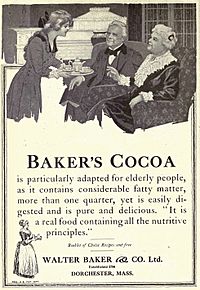
In 1765, chocolate was first introduced in the United States when Irish chocolate maker John Hannon (or alternatively spelled "Hannan" in some sources) imported beans from the West Indies and refined them in Dorchester, working with Dr. James Baker, an American physician and investor. They soon after opened America's first chocolate mill and factory in the Lower Mills section of Dorchester. The Walter Baker Chocolate Factory, part of Walter Baker & Company, operated until 1965.
Before the American Revolution, "The Sons of Liberty met in August 1769 at the Lemuel Robinson Tavern, which stood on the east side of the upper road (Washington St.) near the present Fuller Street. Lemuel Robinson was a representative of the town during the Revolution and was appointed a colonel in the Revolutionary army." Dorchester (in a part of what is now South Boston) was also the site of the Battle of Dorchester Heights in 1776, which eventually resulted in the British evacuating Boston.
19th century
Victorian era

In Victorian times, Dorchester became a popular country retreat for Boston elite, and developed into a bedroom community, easily accessible to the city—a streetcar suburb. The mother and grandparents of John F. Kennedy lived in the Ashmont Hill neighborhood while John F. "Honey Fitz" Fitzgerald was mayor of Boston.
The American poet Oliver Wendell Holmes, wrote a poem called "The Dorchester Giant" in 1830, and referred to the special kind of stone, "Roxbury puddingstone", also quarried in Dorchester, which was used to build churches in the Boston area, most notably the Central Congregational Church (later called the Church of the Covenant) in Boston's Back Bay neighborhood.
In 1845, the Old Colony Railroad ran through the area and connected Boston and Plymouth, Massachusetts. The station was originally called Crescent Avenue or Crescent Avenue Depot as an Old Colony Railroad station, then called Columbia until December 1, 1982, and then again changed to JFK/UMASS. It is a Massachusetts Bay Transportation Authority rail line station for both the Red subway and the Plymouth/Kingston, Middleborough/Lakeville and Greenbush commuter rail lines.
In the 1840s and 1850s, a new wave of development took place on a strip of waterfront overlooking Dorchester Bay (Park and Mill Streets at the Harrison Square Historic District, later known as Clam Point.) Renowned architects who had contributed to one of the most significant and intact collections of Clam Point's Italianate mansards include Luther Briggs, John A. Fox, and Mary E. Noyes. By the 1890s, Clam Point gained prominence as a summer resort with the Russell House hotel as its centerpiece and the establishment of the Dorchester Yacht Club on Freeport Street.
In the 1880s, the calf pasture on Columbia Point was used as a Boston sewer line and pumping station. This large pumping station still stands and in its time was a model for treating sewage and helping to promote cleaner and healthier urban living conditions. It pumped waste to a remote treatment facility on Moon Island in Boston Harbor, and served as a model for other systems worldwide. This system remained in active use and was the Boston Sewer system's headworks, handling all of the city's sewage, until 1968 when a new treatment facility was built on Deer Island. The pumping station is also architecturally significant as a Richardsonian Romanesque designed by the then Boston city architect, George Clough. It is also the only remaining 19th century building on Columbia Point and is in the National Register of Historic Places.
Annexation to Boston
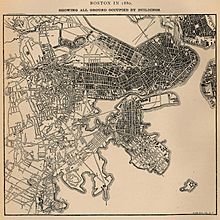
Dorchester was annexed by Boston in pieces beginning on March 6, 1804 and ending with complete annexation to the city of Boston after a plebiscite was held in Boston and Dorchester on June 22, 1869. As a result, Dorchester officially became part of Boston on January 3, 1870. This is also the historic reason that Dorchester Heights is today considered part of South Boston, not modern-day Dorchester, since it was part of the cession of Dorchester to Boston in 1804. Additional parts of Dorchester were ceded to Quincy (in 1792, 1814, 1819, and 1855) and portions of the original town of Dorchester became the separate towns of Hyde Park (1868 and later annexed to Boston in 1912), Milton (1662), and Stoughton (1726, itself later subdivided).
In 1895, Frederick Law Olmsted, architect of the Boston Public Garden/Emerald Necklace and Central Park, was commissioned to create Dorchester Park, to be an urban forest for the residents of a growing Dorchester.
In 1904, the Dorchester Historical Society incorporated "Dorchester Day" which commemorated the settlement of Dorchester in 1630. An annual event, Dorchester Day is a tableau of community events, highlighted by such activities as the Landing Day Observance, the Dorchester Day Parade along Dorchester Avenue the first Sunday in June, and as a grand finale, the Community Banquet.
Turn of the 20th century
There was also increased social activism in Dorchester during the late 19th and early 20th centuries. Dorchester became home to the first racially integrated neighborhood on Jones Hill. One of the residents of that neighborhood, William Monroe Trotter, with W.E.B. Du Bois, helped to found the Niagara Movement, the precursor of the National Association for the Advancement of Colored People. Many leading suffragettes also lived in Dorchester, including Lucy Stone.
In the early 20th century, Dorchester also saw a large influx of new immigrants from origins such as Ireland, French Canada, Poland, Italy, and migrant African Americans from the south. This is the era when the trademark Dorchester triple decker apartment buildings were built.
1950s–present
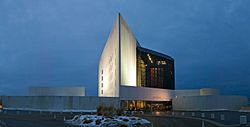
In the early 1950s, Dorchester was also a center of civil rights activism. Martin Luther King, Jr. lived there for much of the time he attended Boston University for his PhD. "With Boston’s Baptist community riveted by his preaching and Coretta [Scott King] at his side, King’s circle grew. The Dorchester apartment drew friends and followers like a magnet, according to [friend and roommate John] Bustamante, with 'untold numbers of visitors coming from the other schools.' The roommates housed and fed the visitors, who would join in civil rights discussions."
During the 1950s–1980s, the ethnic landscape of Dorchester changed dramatically. The Jewish and Irish populations were replaced with African, Asian, and Caribbean populations.
The first community health center in the United States was the Columbia Point Health Center in Dorchester. It was opened in December 1965 and served mostly the massive Columbia Point public housing complex adjoining it. It was founded by two medical doctors, Jack Geiger who had been on the faculty of Harvard University then later at Tufts University and Count Gibson from Tufts University. Geiger had previously studied the first community health centers and the principles of Community Oriented Primary Care with Sidney Kark and colleagues while serving as a medical student in rural Natal, South Africa. The Columbia Point Health Center is still in operation and was rededicated in 1990 as the Geiger-Gibson Community Health Center.
In 1977, after an unsuccessful bid to have the John F. Kennedy Library in Cambridge, Massachusetts close to Harvard University, ground was broken at the tip of Columbia Point for the John F. Kennedy Presidential Library and Museum, designed by the architect I. M. Pei, and dedicated on October 20, 1979.
By the 1980s, the Blue Hill Avenue section of Dorchester had become a predominantly black community. Numerous burned out buildings existed on Blue Hill Ave.
On March 30, 2015, the Edward M. Kennedy Institute for the United States Senate was dedicated by President Barack Obama. The Institute opened to the public on March 31, 2015.
Geography
Dorchester is located south of downtown Boston and is surrounded by the neighborhoods of South Boston, Roxbury, Jamaica Plain, Hyde Park, South End, and the city of Quincy and town of Milton. The Neponset River separates Dorchester from Quincy and Milton. According to the U.S. Postal Service, Dorchester includes the zip codes 02121, 02122, 02124, and 02125.
Neighborhood sections and squares
Dorchester is Boston's largest and most populous neighborhood and comprises many smaller sections and squares. Due to its size of about six square miles, it is often divided for statistical purposes in North and South Dorchester. North Dorchester includes the portion north of Quincy Street, East Street and Freeport Street. The main business district in this part of Dorchester is Uphams Corner, at the intersection of Dudley Street and Columbia Road. South Dorchester is bordered to the east by Dorchester Bay and to the south by the Neponset River. The main business districts in this part of Dorchester are Fields Corner, at the intersection of Dorchester Avenue and Adams Street, and Codman Square, at the intersection of Washington Street and Talbot Avenue. Adjacent to Fields Corner is the Harrison Square Historic District, also known as Clam Point, noteworthy for its collection of substantial Italianate Mansard residences.
Dorchester Avenue is the major neighborhood spine, running in a south-north line through all of Dorchester from Lower Mills to downtown Boston. The southern part of Dorchester is primarily a residential area, with established neighborhoods still defined by parishes, and occupied by families for generations. The northern part of Dorchester is more urban, with a greater amount of apartment housing and industrial parks. South Bay Center and Newmarket industrial area are major sources of employment and the Harbor Point area (formerly known as Columbia Point) is home of several large employers, including the Boston campus of the University of Massachusetts, the Massachusetts Archives and Commonwealth Museum, the Edward M. Kennedy Institute for the United States Senate, and the John F. Kennedy Presidential Library and Museum. Distinct commercial districts include Bowdoin/Geneva, Fields Corner, Codman Square, Peabody Square, Adams Village and Lower Mills. Primarily residential areas include Savin Hill, Jones Hill, Four Corners, Franklin Field, Franklin Hill, Ashmont, Meeting House Hill, Neponset, Popes Hill and Port Norfolk.
Demographics
| Historical population | |||
|---|---|---|---|
| Census | Pop. | %± | |
| 1830 | 4,074 | — | |
| 1840 | 4,875 | 19.7% | |
| 1850 | 7,969 | 63.5% | |
| 1860 | 9,769 | 22.6% | |
Up until the 1960s, the Blue Hill Avenue part of Dorchester from Roxbury to Mattapan was primarily composed of Jewish Americans who had lived there for generations. The Neponset neighborhood was primarily Irish-American. During the 1920s–1960s, many African-Americans moved from the South to the North during the Great Migration and settled on Blue Hill Avenue and nearby sections. While some Jewish-Americans were moving "up and out" to the suburbs, certain Boston banks and real estate companies developed a blockbusting plan for the area. The Blue Hill Avenue area was "redlined" so that only the newly arriving African-Americans would receive mortgages for housing in that section. "White flight" was prevalent. Later, Dorchester had another wave of immigrants, this time from Puerto Rico, the Dominican Republic, Haiti, Jamaica, Trinidad and Tobago, Vietnam, Cape Verde, as well as other Latin American, Asian, and African nations. Dorchester continued to experience immigration from Northern European countries such as Ireland, Germany and Poland. This made Dorchester more diverse than at any point in its long history, and home to more people from more countries than ever before. These immigrants helped revive economically many areas of the neighborhood by opening ethnic stores and restaurants.
The sections of Dorchester have distinct ethnic, racial, and socioeconomic compositions. The eastern areas of Dorchester (especially between Adams Street and Dorchester Bay) are primarily ethnic European and Asian, with a large population of Irish Americans and Vietnamese Americans, while the residents of the western, central and parts of the southern sections of the neighborhood are predominantly African Americans. In Neponset, the southeast corner of the neighborhood, as well as parts of Savin Hill in the north and Cedar Grove in the south, Irish Americans maintain the most visible identity. In the northern section of Dorchester and southwestern section of South Boston is the Polish Triangle, where recent Polish immigrants are residents. Savin Hill, as well as Fields Corner, have large Vietnamese American populations. Uphams Corner contains a Cape Verdean American community, the largest concentration of people of Cape Verdean origin within Boston city limits. Western, central and parts of southern Dorchester have a large Caribbean population (especially people from Haiti, Jamaica, Barbados, and Trinidad and Tobago). They are most heavily represented in the Codman Square, Franklin Field and the Ashmont area, although there are also significant numbers in Four Corners and Fields Corner. Significant numbers of African Americans live in the Harbor Point, Uphams Corner, Fields Corner, Four Corners and Franklin Field areas. In recent years Dorchester has also seen an influx of young residents, gay men and women, and working artists (in areas like Lower Mills, Ashmont Hill/Peabody Square, and Savin Hill).
American Community Survey – Estimates – 2013
The American Community Survey (ACS) for Dorchester, from 2007–2011, estimates the total population is 113,975 people. Slightly more than half are female, 52.6% or 59,914 and 47.4% or 54,061 are male.
In Dorchester, 68.4% or 77,980 of the residents are native born and 31.6% or 35,995 people are foreign born, of which 50.1% or 18,024 are not U.S. citizens. The largest racial group in the neighborhood is Black or African-American with 49,612 people or 43.05% of the population. People who self-identify as white represent 26,102 or 26.99% of the community. Hispanic/Latino account for 19.09% of the population with 19,295 resident. The Asian enclave represents 9.6% of 10,990 of the citizenry. The smallest racial group is bi/multi-racial and they make up 1.9% (2,174) of the population.
According to the ACS survey, Dorchester has a large under 25 population with 38.1% or 43,472 people and 33,162 (29.1% of the total population) of them under the age of 19 years old. Between the ages of 25 to 64 years old there are 59,788 or 52.6% people and 10,715 people or 9.3% are over the age of 65 years old. In Dorchester, approximately 61.9% or 70,503 people are over the age of 25, 23.5% or 16,582 people do not have a high school diploma or GED, 30.5% or 21,479 have a diploma or GED, 18.5% or 13,045 people have completed some college, and 27.5% or 19,397 people have a college degree.
The ACS Survey estimates there are 40,443 households in the neighborhood of Dorchester, the per capita income of $22,120 and a median income of $44,136. 13.1% or 5,286 households have reported income of less than $10,000. 27.3% or 11,020 households earn less than $19,999. 19.1% or 7,720 households earn between $20,000 to 39,999.16.5% or 6,651 households in the earn between $40,000 to 59,999. 19.7% or 7,977 households earn between $60,000 to 99,999. 15.3% or 6,174 of household report annual incomes of $100,000 to 199,999. Only 2.2% or 901 households in Dorchester earn $200,000 or more per year. The ACS reports as of 2011, Poverty affects 23.5% or 9,511 households and 24.3% or 9,820 of households are receiving SNAP Benefits.
Race
| Race | Percentage of 02121 population |
Percentage of Massachusetts population |
Percentage of United States population |
ZIP Code-to-State Difference |
ZIP Code-to-USA Difference |
|---|---|---|---|---|---|
| Black | 70.9% | 8.8% | 13.4% | +62.1% | +57.5% |
| Hispanic | 28.7% | 11.9% | 18.1% | +16.8% | +10.6% |
| White | 8.2% | 81.3% | 76.6% | –73.1% | –68.4% |
| White (Non-Hispanic) | 2.6% | 72.1% | 60.7% | –69.5% | –58.1% |
| Asian | 0.8% | 6.9% | 5.8% | –6.1% | –5.0% |
| Native Americans/Hawaiians | 0.2% | 0.6% | 1.5% | –0.4% | –1.3% |
| Two or more races | 5.2% | 2.4% | 2.7% | +2.8% | +2.5% |
| Race | Percentage of 02122 population |
Percentage of Massachusetts population |
Percentage of United States population |
ZIP Code-to-State Difference |
ZIP Code-to-USA Difference |
|---|---|---|---|---|---|
| White | 37.7% | 81.3% | 76.6% | –43.6% | –38.9% |
| White (Non-Hispanic) | 34.1% | 72.1% | 60.7% | –38.0% | –26.6% |
| Black | 30.9% | 8.8% | 13.4% | +22.1% | +17.5% |
| Asian | 18.4% | 6.9% | 5.8% | +11.5% | +12.6% |
| Hispanic | 11.9% | 11.9% | 18.1% | +0.0% | –6.2% |
| Native Americans/Hawaiians | 0.0% | 0.6% | 1.5% | –0.6% | –1.5% |
| Two or more races | 3.5% | 2.4% | 2.7% | +1.1% | +0.8% |
| Race | Percentage of 02124 population |
Percentage of Massachusetts population |
Percentage of United States population |
ZIP Code-to-State Difference |
ZIP Code-to-USA Difference |
|---|---|---|---|---|---|
| Black | 64.4% | 8.8% | 13.4% | +55.6% | +61.0% |
| White | 22.6% | 81.3% | 76.6% | –58.7% | –54.0% |
| White (Non-Hispanic) | 16.3% | 72.1% | 60.7% | –55.8% | –44.4% |
| Hispanic | 15.8% | 11.9% | 18.1% | +3.9% | –2.3% |
| Asian | 6.2% | 6.9% | 5.8% | –0.7% | +0.4% |
| Native Americans/Hawaiians | 1.1% | 0.6% | 1.5% | +0.5% | –0.4% |
| Two or more races | 2.9% | 2.4% | 2.7% | +0.5% | +0.2% |
| Race | Percentage of 02125 population |
Percentage of Massachusetts population |
Percentage of United States population |
ZIP Code-to-State Difference |
ZIP Code-to-USA Difference |
|---|---|---|---|---|---|
| White | 34.2% | 81.3% | 76.6% | –47.1% | –42.4% |
| White (Non-Hispanic) | 30.4% | 72.1% | 60.7% | –41.7% | –30.3% |
| Black | 29.7% | 8.8% | 13.4% | +20.9% | +16.3% |
| Hispanic | 20.3% | 11.9% | 18.1% | +8.4% | +2.2% |
| Asian | 12.8% | 6.9% | 5.8% | +5.9% | +7.0% |
| Native Americans/Hawaiians | 0.5% | 0.6% | 1.5% | –0.1% | +1.0% |
| Two or more races | 5.1% | 2.4% | 2.7% | +2.7% | +2.4% |
Ancestry
According to the 2012-2016 American Community Survey 5-Year Estimates, the largest ancestry groups in ZIP Codes 02121, 02122, 02124, and 02125 are:
| Ancestry | Percentage of 02121 population |
Percentage of Massachusetts population |
Percentage of United States population |
ZIP Code-to-State Difference |
ZIP Code-to-USA Difference |
|---|---|---|---|---|---|
| West Indian | 15.53% | 1.96% | 0.90% | +13.57% | +14.62% |
| Puerto Rican | 10.76% | 4.52% | 1.66% | +6.24% | +9.10% |
| Sub-Saharan African | 7.82% | 2.00% | 1.01% | +5.82% | +6.81% |
| Haitian | 7.18% | 1.15% | 0.31% | +6.02% | +6.87% |
| Jamaican | 4.22% | 0.44% | 0.34% | +3.78% | +3.88% |
| Cape Verdean | 3.92% | 0.97% | 0.03% | +2.95% | +3.89% |
| American | 2.84% | 4.26% | 6.89% | –1.42% | –4.05% |
| Somali | 1.57% | 0.06% | 0.04% | +1.50% | +1.52% |
| Ancestry | Percentage of 02122 population |
Percentage of Massachusetts population |
Percentage of United States population |
ZIP Code-to-State Difference |
ZIP Code-to-USA Difference |
|---|---|---|---|---|---|
| Irish | 18.94% | 21.16% | 10.39% | –2.22% | +8.55% |
| Vietnamese | 16.67% | 0.69% | 0.54% | +15.98% | +16.13% |
| Sub-Saharan African | 10.85% | 2.00% | 1.01% | +8.85% | +9.84% |
| Cape Verdean | 8.57% | 0.97% | 0.03% | +7.60% | +8.54% |
| Italian | 6.43% | 13.19% | 5.39% | –6.75% | +1.04% |
| West Indian | 5.61% | 1.96% | 0.90% | +3.65% | +4.70% |
| Puerto Rican | 4.67% | 4.52% | 1.66% | +0.15% | +3.01% |
| American | 3.55% | 4.26% | 6.89% | –0.71% | –3.34% |
| Haitian | 2.36% | 1.15% | 0.31% | +1.21% | +2.05% |
| Polish | 1.93% | 4.67% | 2.93% | –2.73% | –1.00% |
| English | 1.66% | 9.77% | 7.67% | –8.12% | –6.01% |
| Jamaican | 1.59% | 0.44% | 0.34% | +1.15% | +1.25% |
| German | 1.39% | 6.00% | 14.40% | –4.61% | –13.01% |
| Asian Indian | 1.19% | 1.39% | 1.09% | –0.20% | +0.10% |
| French | 1.09% | 6.82% | 2.56% | –5.74% | –1.47% |
| Ancestry | Percentage of 02124 population |
Percentage of Massachusetts population |
Percentage of United States population |
ZIP Code-to-State Difference |
ZIP Code-to-USA Difference |
|---|---|---|---|---|---|
| West Indian | 19.04% | 1.96% | 0.31% | +17.08% | +18.14% |
| Haitian | 8.14% | 1.15% | 0.31% | +6.99% | +7.83% |
| Irish | 7.97% | 21.16% | 10.39% | –13.18% | –2.41% |
| Sub-Saharan African | 7.54% | 2.00% | 1.01% | +5.54% | +6.52% |
| Puerto Rican | 7.50% | 4.52% | 1.66% | +2.98% | +5.84% |
| Jamaican | 5.39% | 0.44% | 0.34% | +4.95% | +5.04% |
| Vietnamese | 4.83% | 0.69% | 0.54% | +4.14% | +4.29% |
| Cape Verdean | 3.96% | 0.97% | 0.03% | +2.99% | +3.93% |
| American | 2.74% | 4.26% | 6.89% | –1.53% | –4.16% |
| Trinidadian/Tobagonian | 2.62% | 0.10% | 0.07% | +2.52% | +2.55% |
| English | 2.23% | 9.77% | 7.67% | –7.54% | –5.44% |
| Italian | 2.16% | 13.19% | 5.39% | –11.03% | –3.23% |
| German | 1.29% | 6.00% | 14.40% | –4.72% | –13.12% |
| Barbadian | 1.14% | 0.08% | 0.02% | +1.05% | +1.12% |
| Guyanese | 1.11% | 0.03% | 0.07% | +1.08% | +1.04% |
| Ancestry | Percentage of 02125 population |
Percentage of Massachusetts population |
Percentage of United States population |
ZIP Code-to-State Difference |
ZIP Code-to-USA Difference |
|---|---|---|---|---|---|
| Sub-Saharan African | 15.27% | 2.00% | 1.01% | +13.27% | +14.26% |
| Cape Verdean | 13.02% | 0.97% | 0.03% | +12.05% | +12.98% |
| Irish | 9.34% | 21.16% | 10.39% | –11.82% | –1.05% |
| American | 9.07% | 4.26% | 6.89% | +4.81% | +2.18% |
| Vietnamese | 7.33% | 0.69% | 0.54% | +6.64% | +6.79% |
| Puerto Rican | 6.90% | 4.52% | 1.66% | +2.38% | +5.24% |
| West Indian | 5.26% | 1.96% | 0.90% | +3.30% | +4.36% |
| Italian | 3.18% | 13.19% | 5.39% | –10.00% | –2.21% |
| Chinese | 3.03% | 2.28% | 1.24% | +0.75% | +1.79% |
| Polish | 2.92% | 4.67% | 2.93% | –1.75% | –0.02% |
| German | 2.32% | 6.00% | 14.40% | –3.69% | –12.08% |
| English | 2.12% | 9.77% | 7.67% | –7.66% | –5.55% |
| Haitian | 1.94% | 1.15% | 0.31% | +0.79% | +1.64% |
| Albanian | 1.50% | 0.28% | 0.06% | +1.22% | +1.44% |
| Arab | 1.44% | 1.10% | 0.59% | +0.35% | +0.85% |
| Mexican | 1.29% | 0.67% | 11.96% | +0.62% | –10.67% |
| Asian Indian | 1.20% | 1.39% | 1.09% | –0.19% | +0.11% |
| French | 1.05% | 6.82% | 2.56% | –5.77% | –1.51% |
Transportation
The neighborhood is served by five stations on the Massachusetts Bay Transportation Authority Red Line (MBTA) rapid transit service, five stations on the Ashmont-Mattapan High Speed Line, five stations on the Fairmount Commuter Rail Line, and various bus routes. Over the last decade, the Dorchester branch of the Red Line had major renovations, including four rapid transit stations being rebuilt at Savin Hill, Fields Corner, Shawmut, and Ashmont. At Ashmont station, the city of Boston and the state of Massachusetts partnered with private investors to create The Carruth, one of the state's first Transit-oriented developments (TOD).
Interstate 93 (concurrent with Route 3 and U.S. 1) runs north–south through Dorchester between Quincy, Massachusetts, and downtown Boston, providing access to the eastern edge of Dorchester at Columbia Road, Morrissey Boulevard (northbound only), Neponset Circle (southbound only), and Granite Avenue (with additional southbound on-ramps at Freeport Street and from Morrissey Blvd at Neponset). Several other state routes traverse the neighborhood, e.g., Route 203, Gallivan Boulevard and Morton Street, and Route 28, Blue Hill Avenue (so named because it leads out of the city to the Blue Hills Reservation). The Neponset River separates Dorchester from Quincy and Milton. The "Dorchester Turnpike" (now "Dorchester Avenue") stretches from Fort Point Channel (now in South Boston) to Lower Mills, and once boasted a horse-drawn streetcar.
A number of the earliest streets in Dorchester have changed names several times through the centuries, meaning that some names have come and gone. Leavitt Place, for instance, named for one of Dorchester's earliest settlers, eventually became Brook Court and then Brook Avenue Place. Gallivan Boulevard was once Codman Street and Brookvale Street was once Brook Street. Morrissey Boulevard was once Old Colony Parkway.
Safety
Boston Police District C-11 Dorchester, located 40 Gibson St, Dorchester, MA 02122. To create an environment of trust, and empower the neighborhood is the goal. There are over 50 community meetings held monthly that allow the police department to partner with the seniors, community residents, business as well as the faith-based leaders of Dorchester. The police department also works closely to provide the community with crime prevention and safety tips. "Communication is the life-blood of our neighborhood"
Dorchester has available shelters for those in need, a homeless shelter by the name of Pilgrim church (children's services of Roxbury) that is an adult shelter open to men only. This shelter is located on 540 Columbia Road Dorchester MA The shelter is run by the Pilgrim church and it offers over night shelter, food, clothing, showers, first aid, and other supportive services. The shelter also provides evening transportation from Boston to the shelter. The shelter was originally established in 1990 by positive lifestyles and now is currently under the direction of United Homes Adult services.
Public Utilities
- Basic Services
- Public works department
- To get information about trash pick up Sanitation department (617-635-7573)
- Boston recycling (617-635-4959)
- To report pot holes (617-635-4500)
Urban Policies
Income – Massachusetts sales tax rate is 6.25%, income tax is 5.20%. Income per capita is $18,226 which includes adults and children. Median household income $30,419.
Public Policy Issues
There are many controversial public issues that are on the agenda for action by the city hall in Boston. These controversial issues have been in the works for months even years and many of the Dorchester residents are being directly affected along with the quality of their lives. Local residents and activist are working together to find ways to address the issues not only for them and their children but their neighborhoods as well. Some of the problems are public safety, high crime volume, poor educational resources, and lack of housing for low income families. The goals of the organizations are to provided the neighborhood with
- Good Jobs/living wage
- Education for the children
- Housing
- Healthcare resources & Access
- Public Safety & Policy Relations
The Two organizations that are working close knit to tackle these issues; First Parish Dorchester and The Bowdoin Geneva Resident Association.
City Budget Plans
Mayor Marty Walsh proposed a budget for 2017 in which included is a five-year capital plan that is intended to make improvements to the infrastructure of Dorchester. The new projects involve building new libraries and also a modernizing the Boston Public Libraries branches in Dorchester. The City parks are also another investment Walsh intends to take on in the Five year capital plan. The plans are to add more lights to Doherty-Gibson park in Fields Corner and another $3.7 million to make improvements in Harambee park next to the Franklin Field. The rest of the budget is intended to be used to complete already started projects in Savin Hill, King Street, Hemenway, Dower Avenue, and Ronan Park.
Community Resource
Education
Based on the 2010 Census Dorchester has 114,235 for a total population. Just about 15,530 are under the age of eighteen, with this they should all be attending school.
Food
The former president of Trader Joes opened a non-profit retail food shop called the Daily Table,
Leisure activities and areas
Parks
- Pope John Paul II Park Reservation: The Pope John Park Reservation is approximately 66 acres in size, and is also open year-round for the residents of Dorchester. In its earlier times it was used as a landfill and also a drive-in theatre. It also serves as a barricade between the Town of Dorchester, Boston Boston and Neponset River Neponset River waterfront. This park now gives residents various resources such as; Picnic facilities, soccer fields, play areas, paths for walking, and also spacious land to plant trees and shrubs. Unfortunately, it was not always like this. In May 2015 According to James W. Dolan Pope John Paul Park Reservation was not the same as it used to be. The State Department of Conservation and Recreation which is responsible for the park is not really doing its job. The plants are either dead or overgrown. There are no gardens or trees that would catch anyone's eye and also no picnic tables or grills where families could gather around and do a cookout. Dolan states that he wants to see people of the community planting vegetables and tending flower beds in the park, he wants to see people paddling canoes in the river and also a grove of trees so people could sit in the shade and look out at the river.
- Dorchester Park: Dorchester park was established in 1861 and is located in the southern part of Dorchester, specifically in the Cedar Grove and Lower Mills; it is also across from the Neponset River. Dorchester Park is 30 acres and many events are taken place in this historical park, one being the Annual Classic Car Show and Family Fun Day . Dorchester was also listed in the National Registrar of Historic Places .
- Franklin Park: Established in 1885 this parks 485 acres include paved paths which are perfect for taking a nice run, walking and enjoying the scenery, tennis courts, baseball fields, golf courses, and also basketball courts. Also something that is part of Franklin park is New Englands Franklin Park Zoo , where people go to explore the 9 main exhibits that contain more than 220 species of animals. Another activity that is open to the public is Kite and Bike festival which traditionally takes part in Franklin park. This event usually always lands the Saturday after Mothers day. Nearly 100 bikes are provided by Bostons Bike, these bikes range from all sizes for both children and adults. Dotbike volunteers then lead tours around the park so people can get used to riding the bikes. Aside from riding bikes, people are also allowed to fly kites with their families.
Bike Trails
- Lower Neponset River Trail: This 2.4 mile path stretches from the historic port of Norfolk neighborhood in Dorchester, through Pope John Paul II Park, across from Granite Avenue through Neponset Marshes, and through the Lower Mills area to Central Avenue in Milton. This trail is used for running, biking, and also walking. The Neponset River Trial is adjacent to the Butler, Milton village, and Central Avenue Red Line stations which is a way some individuals that may not have their own transportation can get to the trial.
- Neponset River Green way: The Neponset River Green way totals 5 miles in length, it provides scenery to look at while taking a stroll, run, or bike ride such as; a salt marsh in Pope John Paul Park II and Tenan Beach on the mouth of Neponset River . Conveniently the trail is adjacent to three Massachusetts Bay Transportation Authority red line stations such as; Butler, Milton, and Central Avenue.
Sites of interest
- Bayside Expo Center (also known as the Bayside Expo and Conference Center), originally opened as a shopping mall in the 1960s and in 2010 sold to University of Massachusetts Boston for future redevelopment
- The Boston Globe building
- Captain Lemuel Clap House
- Commonwealth Museum
- Dorchester Park
- Edward M. Kennedy Institute for the United States Senate
- First Parish Church of Dorchester
- Franklin Park Zoo
- James Blake House
- John F. Kennedy Presidential Library and Museum
- Neponset River State Reservation
- University of Massachusetts Boston Harbor Campus
- William Clapp House
- William Monroe Trotter House
- Eire Pub, visited by presidents and prime ministers and political candidates
Economy
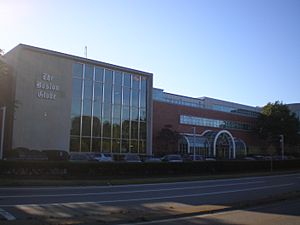
Throughout its history, Dorchester has had periods of economic revival and recession. In the 1960s and 1970s, Dorchester was particularly hard hit by economic recession, high unemployment, and white flight.
In 1953, Carney Hospital moved from South Boston to its current location in Dorchester, serving the local communities of Dorchester, Mattapan, Milton and Quincy.
In 1953, a major public housing project was completed on the Columbia Point peninsula of Dorchester. There were 1,502 units in the development on 50 acres (200,000 m2) of land. It later became known for high rates of crime and poor living conditions, and it went through particularly bad times in the 1970s and 1980s. By 1988, there were only 350 families living there. In 1984, the City of Boston gave control of it to a private developer, Corcoran-Mullins-Jennison, who redeveloped the property into a residential mixed-income community called Harbor Point Apartments which was opened in 1988 and completed by 1990. It was the first federal housing project to be converted to private, mixed-income housing in the United States. Harbor Point has won much acclaim for this transformation, including awards from the Urban Land Institute, the FIABCI Award for International Excellence, and the Rudy Bruner Award for Urban Excellence.
During the housing crisis of 2008 in the United States, Dorchester's Hendry Street became the epicenter in the media In reaction, the city of Boston negotiated to buy several of the houses for as little as $30,000. It is moving to seize other foreclosed properties on which the owners have not paid taxes. The houses were renovated and added to the inventory of subsidized rental housing.
In 2008, plans and proposals were unveiled and presented to public community hearings by the Corcoran-Jennison Company to redevelop the 30-acre (120,000 m2) Bayside Exposition Center site on the Columbia Point peninsula into a mixed use village of storefronts and residences, called "Bayside on the Point". However, in 2009, the Bayside Expo Center property was lost in a foreclosure on Corcoran-Jennison to a Florida-based real estate firm, LNR/CMAT, who bought it. Soon after, the University of Massachusetts Boston bought the property from them to build future campus facilities.
The corporate headquarters of The Boston Globe was also located in Dorchester, having moved there in 1958 from downtown Boston. In 2009, then-owner The New York Times Company put the paper up for bid, leading to concern from local community members, who had seen other major employers close their doors. After negotiations with their union and cost reduction measures, the owner's plans to sell the Globe were abandoned in October 2009. In 2013, the paper was bought by John W. Henry, owner of the Boston Red Sox, and in 2017 the Globe headquarters returned to downtown Boston.
In the 20th century, many of the labor unions in Boston relocated their headquarters to Dorchester. This includes the Boston Teachers Union, International Brotherhood of Electrical Workers Local 103, New England Regional Council of Carpenters, International Association of Fire Fighters Local 718, among others.
Education
Primary and secondary schools
Public schools
Students in Dorchester are served by Boston Public Schools (BPS). BPS assigns students based on preferences of the applicants and priorities of students in various zones.
Dorchester High School predated the annexation of Dorchester to Boston. At its founding, it was an all-male school, first opened on December 10, 1852. In 1870 Dorchester was annexed to Boston and its schools became managed by the City of Boston. A replacement facility opened in Codman Square on Talbot Avenue 1901. The current Dorchester facility opened in 1925 on Peacevale Road to males, while the Talbot Avenue building was for females. In 1953 Dorchester High School consolidated as a coeducational school.
BPS schools located in Dorchester include
- Boston Arts Academy, 9–12
- Boston Community Leadership Academy/McCormack, 7–9
- Boston International Newcomers Academy, 9–12
- Boston Latin Academy, 7–12
- Jeremiah E. Burke High School, 9–12
- Clap Elementary, K1–5
- Community Academy of Science & Health, 9–12
- Paul A. Dever Elementary, K1–6
- Edward Everett Elementary, K1–5
- Lilla G. Frederick Pilot Middle School, 6–8
- Sarah Greenwood, K0–8
- Dr. William W. Henderson Inclusion School (formerly Patrick O'Hearn Elementary School), K0–12
- Oliver Wendell Holmes Innovation School, K1–5
- Thomas J. Kenny Elementary, K1–6
- Martin Luther King, Jr., K1–8
- Lee Academy Pilot School, K0–3
- Joseph Lee, K1–8
- Mather Elementary, K1–5
- Richard J. Murphy, K1–8
- William E. Russell Elementary, K1–5
- Pauline A. Shaw Elementary, K0–3
- TechBoston Academy, 6–12
- William Monroe Trotter, K1–8
- UP Academy Dorchester, K1–8 (in-district charter)
- UP Academy Holland, K1–5 (in-district charter)
- John Winthrop Elementary, K1–5
Charter schools include
- Boston Collegiate Charter School, 5–12
- Brooke High School, 9–12
- Codman Academy Charter Public School, K1–12
- Conservatory Lab Charter School, K1–8
- Helen Y. Davis Leadership Academy Charter Public School, 6–8
- Neighborhood House Charter School, K1–12
- Roxbury Prep Lucy Stone Campus, 5–8
- Roxbury Prep Dorchester Campus, 5–8
Catholic schools
Many Catholic schools closed in the 2000s. The remaining schools as of summer 2018 are:
- Boston College High School, 7–12
- Cristo Rey Boston High School, 9–12, leasing the old St. William Elementary building
- St. Brendan School, K-6
- Three locations of the Pope John Paul II Catholic Academy part of the Roman Catholic Archdiocese of Boston remain after the 2008 consolidation of seven parish elementary schools into five locations.
- Columbia Campus (former St. Margaret's Elementary School building)
- Lower Mills Campus (former St. Gregory Elementary School building)
- Neponset Campus (former St. Ann Elementary School building)
Colleges and universities
- The University of Massachusetts Boston is an accredited urban public research university and the second largest campus in the University of Massachusetts system. It is located on Columbia Point in Dorchester. The school offers associates, bachelors, masters and doctoral degrees. In regards to race and gender, the school has a diverse student population of about 13 thousand students at a time. Excluding financial aid, the average cost of tuition is 12 thousand in-state and 28 thousand out of state. The cost reflects good value seeing that there is about a 15:1 student faculty ratio with a variety of majors to study. The economy of the school has been consistently productive since its establishment. Within the past twenty years the school campuses have been improving and expanding. The college has been educating and social developing its residents seeing that 95% of students are instate going full-time.
- Labouré College is a Roman Catholic co-educational college offering associate degrees in nursing and the health sciences. It is located on the Carney Hospital campus near the Lower Mills section of Dorchester.
Public libraries
Boston Public Library operates six neighborhood branches in Dorchester.
- Adams Street Branch
- Codman Square Branch – Originally opened at 6 Norfolk Street in 1905 and was named after a preacher named John Codman. The branch moved into its current facility, which was designed by Eco-Texture, Inc., in 1978.
- Fields Corner Branch
- Grove Hall Branch
- Lower Mills Branch
- Uphams Corner Branch
Notable people
- Charles Baker Adams – born in Dorchester; academic and naturalist
- William Taylor Adams – wrote fiction under pseudonym "Oliver Optic," served on Dorchester school board
- Sheldon Adelson – born and raised in Dorchester; chairman and CEO of Las Vegas Sands Corporation and conservative political financier
- Samuel Turell Armstrong – born in Dorchester; 6th Mayor of Boston and Lieutenant Governor of Massachusetts
- Major General Humphrey Atherton (born c. 1608-1661), an early settler of Dorchester, who held the highest military rank in colonial New England
- Robert Bergenheim – raised in Dorchester; founder of Boston Business Journal
- Ray Bolger – vaudevillian and film actor, best known as Scarecrow in classic movie The Wizard of Oz (1939)
- Jean Buckley – born in Dorchester; All-American Girls Professional Baseball League player
- William M. Bulger – politician, former President of the Massachusetts Senate and president of University of Massachusetts
- Herb Chambers – owner and CEO of Herb Chambers Companies, car dealerships
- Buddy Clark - easy-listening-jazz singer
- Arthur Colgan - Roman Catholic bishop
- Clarence Cook – born in Dorchester; 19th Century art critic and writer
- Michael L. Coyne – trial attorney and professor, co-founder and associate dean of Massachusetts School of Law
- Norm Crosby – entertainer
- Thomas M. Finneran – former Speaker of the Massachusetts House of Representatives; in 2007, pleaded guilty to felony obstruction of justice
- Tom Fitzgerald, ice hockey and golf journalist
- Mike Gorman – TV play-by-play announcer for Boston Celtics
- Harry G. Hamlet – Commandant of U.S. Coast Guard 1932-36, attended high school in Dorchester
- Kay Hanley – alternative rock musician, vocalist for band Letters to Cleo
- Chrystal Herne – Broadway actress
- Richard M. Karp – raised in Dorchester; Turing Award-laureate computer scientist
- Joseph P. Kennedy – businessman, political figure, father of President John F. Kennedy, Robert F. Kennedy and Edward M. "Ted" Kennedy
- Rose Kennedy – mother of John F. Kennedy, Robert F. Kennedy, and Edward M. "Ted" Kennedy
- John King – broadcast journalist, host of Inside Politics on CNN
- Jonathan Knight – singer, musical group New Kids on the Block
- Jordan Knight – singer, New Kids on the Block
- Calixa Lavallée – Canadian national anthem composer, wrote offertorium for dedication of St. Peter's of Dorchester (1883)
- Dennis Lehane – raised in Dorchester; author of Gone Baby Gone, Mystic River, Shutter Island; screenwriter, producer
- Alexandra Lydon – born in Dorchester; actress and writer
- Bill Marshall – professional baseball player of 1930s
- John Mason – Colonial military officer, civil engineer
- Increase Mather – Puritan minister; public figure in early history of Massachusetts Bay Colony
- Aaron Maund – professional soccer player
- Albert and David Maysles – documentary filmmakers
- Marilyn Mosby – raised in Dorchester; state's attorney of Baltimore
- John Lothrop Motley – historian and diplomat
- Adam Myerson – professional cyclist
- Leonard Nimoy – born in Dorchester; actor, director, poet, musician, and photographer; best known as Spock on Star Trek
- Bill O'Brien – born in Dorchester; head coach of NFL's Houston Texans
- Lawrence O'Donnell – raised in Dorchester; former aide to Senator Daniel Patrick Moynihan, producer of The West Wing and host of MSNBC's The Last Word with Lawrence O'Donnell
- Rose Pitonof (1895–1984) – marathon swimmer
- Omega Red – rapper, musician and actor
- Martin Richard – raised in Dorchester; one of three people killed in Boston Marathon bombing
- Richard Scarry – raised in Dorchester; children's books author and illustrator, known for his "Busytown" universe
- Slaine – hip-hop MC, rapper and actor, Gone Baby Gone and The Town
- Lucy Stone – abolitionist and suffragist
- Donna Summer – pop and disco singer, member of Rock and Roll Hall of Fame
- Donnie Wahlberg – singer, actor and film producer, member of musical group New Kids on the Block, star of TV series Blue Bloods
- Mark Wahlberg – Academy Award-nominated actor, producer, model and rapper, star of films including Boogie Nights, The Perfect Storm, Ted, The Departed and The Fighter
- Martin Walsh – Mayor of Boston
- John Willis – gangster
- Danny Wood – singer, musical group New Kids on the Block
- Marie Wright – better known by stage name "Free", media personality
Images for kids




